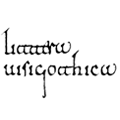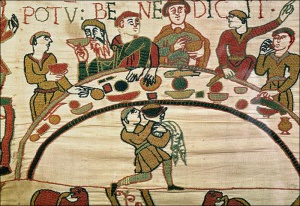Littera Visigothica at the IMC Leeds 2016
Around three months ago, I sent a CFP to participate in a session on the change from Visigothic script to Caroline minuscule in the Iberian Peninsula as part of the International Medieval Congress organised in Leeds every year...
... Well, the call was an extraordinary success with many abstracts received approaching the topic from many different points of view. I am very grateful to all of you who contacted me, as well as to those who help to spread the call. As a consequence of the interest shown, not only one but four very interesting sessions came to be, were proposed to the IMC Leeds Committee, and accepted! Thus, if you are interested in medieval manuscripts from the Iberian Peninsula, in Visigothic script, in medieval musical notation in the Iberian Peninsula, in Peninsular Arabic-Latin scribes, in Caroline minuscule, or in Gothic scripts, to name but a few of the key topics that will be discussed in these four sessions, your place will be Leeds, 2016, 6 of July. We would love to see you there!
From Visigothic script to Caroline minuscule, from Caroline minuscule to Gothic scripts. The reception and evolution of Caroline minuscule in the Iberian Peninsula.
Sponsor: Network for the Study of Caroline Minuscule
Organiser: Ainoa Castro Correa, Department of History, King’s College London
Abstract: While in 11th-century Europe Caroline minuscule was the main writing system used in manuscript production, in most of the Iberian Peninsula this script was just beginning to be used. The persistence of the traditional peninsular script, Visigothic, led to a long and unequal transitional phase towards the new imported graphic system. At the same time, once the change was accepted, its graphic model arrived lacking its essential nature evolving thus quickly to a variety of proto-Gothic scripts which gave back to the Peninsula its graphic particularity. With works on scribes developing their careers in the periods in between writing systems, these sessions aim to explore the contexts of graphic change and polygraphism lived in the Iberian Peninsula from the 11th to the 14th century.
Session I: Visigothic Tradition Fading
This first session kicks off the debate by looking into how Visigothic script began to fade as the main writing system in both manuscript and epigraphic sources. [Moderator/Chair: Ainoa Castro Correa, King’s College London]
- ‘La escritura toledana, mourisca o visigótica en Portugal en el siglo XI’ – María José Azevedo Santos (Universidade de Coimbra)
- Los centros escriptorios en el Reino de León: la transición de la visigótica a la carolina a través de la escritura publicitaria’ – María Encarnación Martín López (Universidad de León)
- The Corsini Beatus: A Transition from the Visigothic Tradition’ – Barbara Shailor (Yale University)
Session II: Resistance to Caroline Minuscule
This second session discusses some of the most significant strongholds of Visigothic script tradition, displaying, through the analysis of manuscript and epigraphic sources, resistance to the graphic change. [Moderator/Chair: Elsa De Luca, University of Bristol]
- ‘De la escritura visigótica a la carolina: Pasos hacia la nueva producción epigráfica en los centros de La Rioja’ – Irene Pereira García (Universidad de León)
- Cultura escrita en el monasterio de Santa María de Monfero (A Coruña): Notarios y ‘scriptores’ de los ss. XII y XIII’ – María Teresa Carrasco Lazareno (Universidad Autónoma de Madrid)
- Abbreviation by superscripted vowel: its arrival and use in documents and books from Castile’ – Francisco J. Molina (Universidad de Valladolid)
Session III: Parallel Changes – Outside the Conflict Visigothic Versus Caroline
At the same time as the collision of the two writing systems, Visigothic and Caroline, took place, other significant changes materialised in manuscript sources. This third session explores coeval changes in musical notation and language as well as in parallel cultural contexts. [Moderator/Chair: Irene Pereira García, Universidad de León]
- ‘Graphical Changes in Old Hispanic Vertical Notation’ – Elsa De Luca (University of Bristol)
- The Signatures in the Mozarabic Documents in Twelfth and Thirteenth-Century Toledo’ – Yasmine Beale-Rivaya (Texas State University)
- Modelos escriturarios arcaicos en la cultura manuscrita gallega siglos XIII-XIV’ – Ricardo Pichel Gotérrez (University of Birmingham)
Session IV: The Brief Life of Caroline Minuscule
Once the Carolingian writing system was finally imposed, its troublesome introduction mirrored in a brief life fading against Gothic scripts. This fourth session closes the topic of graphic change by discussing the last years of Caroline minuscule in the Iberian Peninsula. [Moderator/Chair: Ricardo Pichel Gotérrez, University of Birmingham]
- ‘De la carolina a la gótica en Cataluña: Contextos, lugares, nombres, problemas’ – J. Antoni Iglesias Fonseca (Universitat Autònoma de Barcelona)
- El proceso de gotización de la escritura carolina en Cataluña’ – Mireia Comas / Daniel Piñol (Universitat de Barcelona)
- De escribas y escrituras en los documentos de Oña, 1107-1215′ – Concepción Mendo Carmona (Universidad Complutense de Madrid)
by A. Castro
[edited 13/07/2018]

